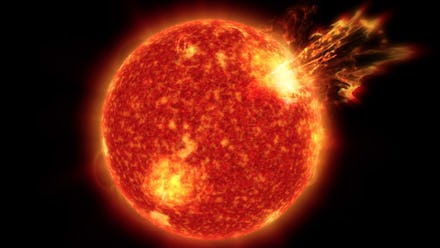Scientists May Have Solved a Huge Mystery About Where Life on Earth Came From

A huge solar flare of high-energy plasma bathing our planet billions of years ago may have created the delicate conditions needed to kickstart life.
Solar flares today are a serious danger to our satellites and communication systems, but they don't happen very often. That wasn't the case 4 billion years ago, when the sun was only about 75% as bright as it is now. Back then, solar storms were raging on the sun, and Earth was getting pummeled by huge "superflares" like this:
Those flares could have changed the chemistry of the atmosphere, warmed the planet and triggered organic molecule formation on the surface.
The research was published May 23 in the journal Nature Geoscience. The researchers figured this out by studying other stars in the universe that look like our sun did when it was younger. Those other stars are regularly emitting superflares, and scientists suspect our sun behaved the same way in its infancy.
A paradox solved? This research is a potential solution to the Faint Young Sun Paradox. Four billion years ago, Earth was receiving much less energy from the sun, so it was likely just a giant, frozen ball.
"Instead, geological evidence says it was a warm globe with liquid water," Vladimir Airapetian, lead author of the paper, said in a NASA statement. "We call this the Faint Young Sun Paradox. Our new research shows that solar storms could have been central to warming Earth."
How did a solar flare kickstart life? When the Earth first formed, it had a much weaker magnetic field and a toxic atmosphere of mostly nitrogen. Huge solar flares of plasma and high-energy particles would have enveloped the planet and broken up the nitrogen into carbon monoxide and oxygen.
That in turn created nitrous oxide, a powerful greenhouse gas that likely warmed up the planet and allowed liquid water to collect on the surface. It also may have triggered the development of organic molecules that allowed more complex life forms to sprout up.
"Our calculations show that you would have regularly seen auroras all the way down in South Carolina," Airapetian said. "And as the particles from the space weather traveled down the magnetic field lines, they would have slammed into abundant nitrogen molecules in the atmosphere. Changing the atmosphere's chemistry turns out to have made all the difference for life on Earth."
Not only could this research help us figure out how life on Earth got started, it could also point us to other worlds that may harbor life.
"We want to gather all this information together, how close a planet is to the star, how energetic the star is, how strong the planet's magnetosphere is in order to help search for habitable planets around stars near our own and throughout the galaxy," William Danchi, principal investigator on the research project, said in the statement.